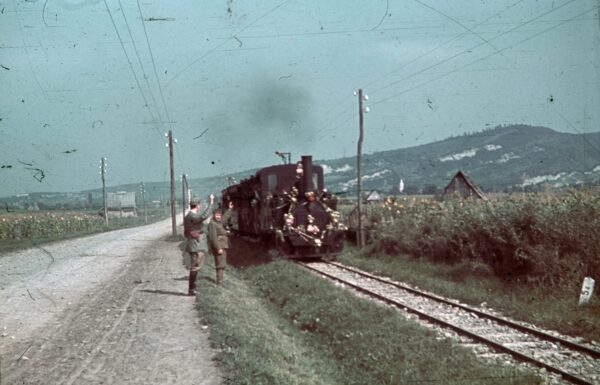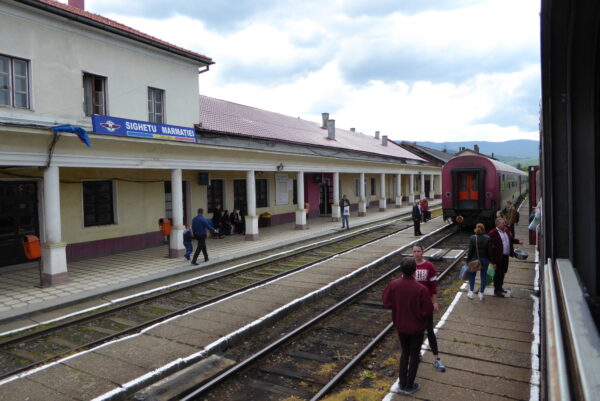Máramaros Salt Railway

The salt railway in the name refers to the fact that the profitability of the railway was ensured in a very unique way, namely by contracting with the Hungarian state to transport the salt.
The salt trade was a state monopoly, and until the construction of the railway, it was typically transported by water, on the Tisza from the Maramures salt flats. The first line, the section from Maramaros Island to Sokamara and Ankaszlatina, was only 4.5 kilometres long and opened on 5 June 1880. It was not yet built as part of the Maramures Salt Road Joint Stock Company, but as an independent industrial railway. The second line was opened on 1 September 1883, connecting Máramarossziget-Sókamara with Rónaszék, and was 20 km long, while the line Máramarossziget-Sókamara-Sugatagi was 20.2 km long on 8 December 1883.
The main difference between the three lines was that the first was licensed as an industrial railway in 1879, as mentioned above, while the lines opened in 1883 were licensed as local interest railways. The reason for this is that the legal environment had changed in the meantime, with the Act XXXI of 1880 allowing the construction of local interest railways under lighter conditions. All three lines were narrow-gauge when they opened, and Ferenc Müller was the main licensee and shareholder on all three lines. The share capital of the joint stock company was HUF 1 598 000, which was covered by the issue of 771 000 ordinary shares and 1 385 500 preference shares. The concessionaires were granted a 30-year licence for the railways, during which time the company entered into a contract with the government for the transport of salt, which covered the revenue from the lines. The railways were initially operated by the Hungarian North-Eastern Railway and then, after nationalisation, by MÁV.
However, it became clear relatively quickly that narrow-gauge lines were not suitable, both because they required the salt to be transhipped onto the normal railway network and because the railways had insufficient capacity to produce salt from the Aknaslatina salt mines. Therefore, in 1887, the joint-stock company applied for permission to convert the railway from Máramarossziget-Sókamária to Aknaszlatina to standard gauge, and for permission to build an additional line to Nagy-Bocskó with a branch line to Kis-Bocskó. At the same time, this railway company was also granted a small 1.8 km section of railway linking Máramarossziget-Sókamária with the railway station at Máramarossziget. The licence for the new railway to Nagy-Bocskó was granted to the joint-stock company for 90 years, while the licences for the existing lines were extended uniformly until 1926.
As Máramarossziget and Aknaszlatina are on opposite banks of the Tisza, the railway line also built Tisza bridges, one at Sókamara in Máramarossziget was a 219.4 m long iron bridge, partly masonry and partly wooden substructure, the other at Bocskó was a 137.7 m long iron bridge.
The Trianon border divided the Maramures salt marshes in two. The border between Czechoslovakia and Romania was formed by the Tisza, i.e. Aknaszlatina became part of Czechoslovakia, Maramures Island became part of Romania, and most of the railway line came under Romanian sovereignty.
The shareholders of the railway, the Müller family, filed a lawsuit against the Romanian state in 1926. In their action, they claimed compensation of 60 million lei because during the revolutions of 1918 and the turbulent times that followed, salt transport had been interrupted, but the Hungarian state had guaranteed certain salt transport traffic, and therefore, as its successor, the Romanian state was obliged to compensate the damage.
The Romanian state wanted to nationalise the joint stock company, but ran into difficulties because members of the Müller family had in the meantime acquired Swiss citizenship and the shares were deposited in Switzerland. The shares in the joint stock company were finally sold to the Czechoslovak and Romanian states at the end of 1926 and beginning of 1927 respectively, so that the shareholders could no longer make claims against either state, but only against the Budapest-based joint stock company. The shares were redeemed for 22.5 pence, and 30 pfennigs for those who had not drawn lots, but it had to be proved that the shares had not been the property of a German or Bulgarian subject since 14 August 1916.

Sources
- Hungarian Compas
- Kovács László (Szerk) Hungarian Railway History 3.
- Pallas Big Dictionary
Founded in 1879
Date of cessation: 1926
Founders: Ferenc Müller
Decisive leaders:
1895-1922 | Id. Dr. Ferenc Chorin |
Main activity: rail transport
Author: by Domonkos Csaba
Founded in 1879
Founders: Ferenc Müller
Decisive leaders:
1895-1922 | Id. Dr. Ferenc Chorin |
Main activity: rail transport
Main products are not set
Seats are not configured
Locations are not set
Main milestones are not set
Author: by Domonkos Csaba
Máramaros Salt Railway

The salt railway in the name refers to the fact that the profitability of the railway was ensured in a very unique way, namely by contracting with the Hungarian state to transport the salt.
The salt trade was a state monopoly, and until the construction of the railway, it was typically transported by water, on the Tisza from the Maramures salt flats. The first line, the section from Maramaros Island to Sokamara and Ankaszlatina, was only 4.5 kilometres long and opened on 5 June 1880. It was not yet built as part of the Maramures Salt Road Joint Stock Company, but as an independent industrial railway. The second line was opened on 1 September 1883, connecting Máramarossziget-Sókamara with Rónaszék, and was 20 km long, while the line Máramarossziget-Sókamara-Sugatagi was 20.2 km long on 8 December 1883.
The main difference between the three lines was that the first was licensed as an industrial railway in 1879, as mentioned above, while the lines opened in 1883 were licensed as local interest railways. The reason for this is that the legal environment had changed in the meantime, with the Act XXXI of 1880 allowing the construction of local interest railways under lighter conditions. All three lines were narrow-gauge when they opened, and Ferenc Müller was the main licensee and shareholder on all three lines. The share capital of the joint stock company was HUF 1 598 000, which was covered by the issue of 771 000 ordinary shares and 1 385 500 preference shares. The concessionaires were granted a 30-year licence for the railways, during which time the company entered into a contract with the government for the transport of salt, which covered the revenue from the lines. The railways were initially operated by the Hungarian North-Eastern Railway and then, after nationalisation, by MÁV.
However, it became clear relatively quickly that narrow-gauge lines were not suitable, both because they required the salt to be transhipped onto the normal railway network and because the railways had insufficient capacity to produce salt from the Aknaslatina salt mines. Therefore, in 1887, the joint-stock company applied for permission to convert the railway from Máramarossziget-Sókamária to Aknaszlatina to standard gauge, and for permission to build an additional line to Nagy-Bocskó with a branch line to Kis-Bocskó. At the same time, this railway company was also granted a small 1.8 km section of railway linking Máramarossziget-Sókamária with the railway station at Máramarossziget. The licence for the new railway to Nagy-Bocskó was granted to the joint-stock company for 90 years, while the licences for the existing lines were extended uniformly until 1926.
As Máramarossziget and Aknaszlatina are on opposite banks of the Tisza, the railway line also built Tisza bridges, one at Sókamara in Máramarossziget was a 219.4 m long iron bridge, partly masonry and partly wooden substructure, the other at Bocskó was a 137.7 m long iron bridge.
The Trianon border divided the Maramures salt marshes in two. The border between Czechoslovakia and Romania was formed by the Tisza, i.e. Aknaszlatina became part of Czechoslovakia, Maramures Island became part of Romania, and most of the railway line came under Romanian sovereignty.
The shareholders of the railway, the Müller family, filed a lawsuit against the Romanian state in 1926. In their action, they claimed compensation of 60 million lei because during the revolutions of 1918 and the turbulent times that followed, salt transport had been interrupted, but the Hungarian state had guaranteed certain salt transport traffic, and therefore, as its successor, the Romanian state was obliged to compensate the damage.
The Romanian state wanted to nationalise the joint stock company, but ran into difficulties because members of the Müller family had in the meantime acquired Swiss citizenship and the shares were deposited in Switzerland. The shares in the joint stock company were finally sold to the Czechoslovak and Romanian states at the end of 1926 and beginning of 1927 respectively, so that the shareholders could no longer make claims against either state, but only against the Budapest-based joint stock company. The shares were redeemed for 22.5 pence, and 30 pfennigs for those who had not drawn lots, but it had to be proved that the shares had not been the property of a German or Bulgarian subject since 14 August 1916.

Sources
- Hungarian Compas
- Kovács László (Szerk) Hungarian Railway History 3.
- Pallas Big Dictionary